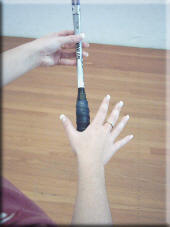More on the Grip
 Squashgame Gold: Advanced Text and Video Content Squashgame Gold: Advanced Text and Video Content
More on the Grip
- Because of the speed of the game of Squash, it is very important to have a good technique.
- Technique starts with the grip of the racket.
- As the game moves from side to side very quickly, sometimes in the air, sometimes deep in the corners or near the back wall, a stable and correct grip will enable you to play a full array of shots from all parts of the court.
- All but advanced players should use the same grip for all shots.
- The grip shown helps develop good swing technique.
- The correct grip makes it easier to play difficult shots - back wall, corners, front court and awkward angled shots
Advanced Grip TechniqueGetting a better feelAs players get a better "feel" for the racket head, and racket strings, angles within the court, speed of the swing, etc. adjustments are easily possible, when required, and make what seems to be an impossible shot very effective, eg.
- shortening of the grip
- relaxing the wrist, especially in the back corners.
All of this done still with control of the racket head. Using the incorrect grip
- A very fit and fast player can play well with a western grip after many hours of practice.
- It is most likely those players would have transferred from another sport and have excellent motor skills.
Discuss This Topic |
The Swing 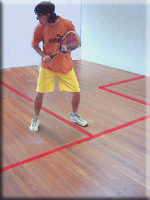
Forehand
- Resembles a sidearm throw or a skimming the stone action where the forearm rotates
. Backhand
- Resembles the throwing of a frisbee, where the forearm rotates, except control the wrist movement which when swinging will control the racket head
Getting Ready
- This is the Ready Position.
- Stand alert for the return of your opponent
- Hold the racket comfortably in front
.
More on Getting Ready
 Squashgame Gold: Advanced Text and Video Content Squashgame Gold: Advanced Text and Video Content
More on Getting Ready
- After watching the ball travel towards your opponent, you should watch your opponent and the ball, gradually focussing in on your opponents stroke.
- Have your racket comfortably positioned in front of you so that you can take it quickly to either side as the return demands.
- As the opponents racket swing commences, attempt to judge the direction and speed of the ball at the earliest possible instant, and move accordingly.
Video clips Analysing the purpose of the swingWhat is the benefit of having a full backswing?
- The longer the backswing the greater the amount of power that can be generated when hitting the ball. This is particularly helpful when retrieving low shots from the back wall whether they be boasts or drives.
- The further the ball is struck behind the body the more difficult it can be to get a full swing. Relaxing the knees, pivotting the hips, and weight transfer will also give more power in the swing.
- From the front of the court it is easier to "hit the ball away"as a cross court drive, with less risk of the ball jagging off the side wall. It is a perfect idea when control is not the important factor, but execution (before the opponent gets back into position) as quickly as possible is vital.
Closely look at the backhand backswing
Beginners may need to exaggerate this movement to get the power out of the corner. There is definitely a knack in getting power into the swing out of this corner.
- It takes a bit of practice to get the shoulder down and the backswing around the body to get the maximum swing.
- It is important to drop the shoulder and flex the hips to increase the length of the swing.
Try recovering impossible shots off the back wall by:
- Getting the maximum amount of backswing.
- Swing under the ball with a racket face virtually parallel to the floor.
- Hit the ball as high up as you can on the side wall, and as far down the side wall as you can.
It is possible to hit the nick with one of these shots so give it a try, it works.
Is there any advantage in having a short backswing:
- The less movement in the swing, the easier to control the racket head, and therefore control the direction of the ball.
- If the ball is returned hard, and by using the opponent's pace, a short controlled stroke can be perfect, especially if volleying.
Video ResourcesVideo clip SwingDriving down the wall
The difficulty in developing an accurate drive is to be able to get the feet and body in position and at the same time keep the swing controlled. Things to think about to be able to achieve this:
- Watch the ball closely
- Judge the speed of the ball to assist early preparation.
- Keep away from the ball and wall to allow adjustment of body positioning.
- Strive to keep the racket head controlled no matter which foot leads into the swing
Video ResourcesDiscuss This Topic |
Backswing 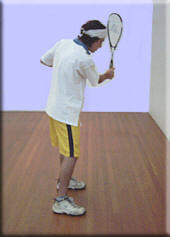
Prepare early for the hit whilst moving to the ball.
The Backswing
- Take the racket back slightly.
- Weight on the back foot.
- Keep racket face open
Note - the racket head is behind the hand/wrist in the early stages of racket preparation, hence the open racket face. . More Pics... FH Early Prep
More on Early Preparation
 Squashgame Gold: Advanced Text and Video Content Squashgame Gold: Advanced Text and Video Content
More on Early Preparation
- Whilst moving to the ball, just prior to playing a shot, the racket should be taken to a comfortable position, ready to hit the ball.
- The early preparation of the racket ensures that the shot commences with the racket head under control, helping execute an accurate shot.
- This prepared position normally sees the racket held comfortably with the racket head at about head height on the side of the body the the shot will be taken.
- Ideally, the racket head should be still before the actual shot commences.
- The racket face should be slightly open.
More on Backswing
More on Backswing
- To commence the shot, the racket will normally be taken up and out (away from the body).
- There will be times when the ball comes very quickly, and there may not be enough time for a backswing.
- The position of the backswing may vary depending on:-
- The type of shot
- The position of the ball
- The position on the court.
- Your position relative to the ball Ideally, the racket head at the top of the backswing, should be aligned to the ball trajectory.
- The racket face should remain open during the backswing. .
Discuss This Topic |
The Downswing 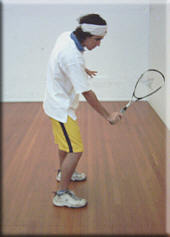
- This is the Hit Position.
- Swing down and through.
- Transfer weight from back to front foot.
. More Pics... FH Downswing
More on Downswing
 Squashgame Gold: Advanced Text and Video Content Squashgame Gold: Advanced Text and Video Content
More on Downswing
- To commence the downswing, create an arc by pulling the racket down and through.
- After the initial movement of the racket head slightly behind the body, it should establish a trajectory which is reasonably straight and is in the direction the shot to be made.
- During this time the racket head should remain very open. As racket/ball impact approaches, the forearm will commence a rotation (pronation/supination) which increases racket head speed considerably. The racket head will start to close as the forearm rotates.
- During the downswing, body weight should move from the back foot to the front foot.
Why lay the racket head back in the downswing?Why lay the racket head back?
- One of the most common problems with a drive, boast and drop shot swing is the failure to "lay the racket head back". By doing this it open the racket face (the butt of the racket points towards the ball) and a full rotation of the swing is possible.
- It is of limited benefit bending the knees to get down to the ball, or down under the ball, and at the same time, having the racket up above your head. As the knees bend the racket head must also go down. In a drive this is sometimes referred to as swinging in a parallel plane.
- If the racket head remains high, and is not laid back) the swing tends to come down on the ball often causing the shots to hit the "tin". Coming down is fine for a volley, or a high bouncing shot, but not for a shot that is lower than the "tin".
Video ResourcesDiscuss This Topic |
Racket/Ball Impact 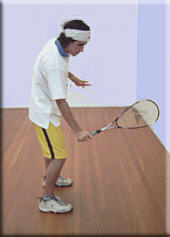
- Forearm Rotation.
- Open Racket face.
- Weight on front foot.
. More Pics... FH Ball Impact
More on Racket/Ball Impact
 Squashgame Gold: Advanced Text and Video Content Squashgame Gold: Advanced Text and Video Content
More on Racket/Ball Impact
- Because of forearm rotation, racket head speed should be at its maximum at racket ball impact, with the racket face at least slightly open.
- The racket head should be moving in a reasonably straight trajectory so that any small differences in the point of impact will not greatly affect the subsequent direction of the ball. Keeping a racket length distance from the ball will increase power and accuracy
- The ball should be watched onto the racket.
Video clip he hitting zoneSome say squash is a wristy game.
- In some players there seems to be a definite snap of the wrist on ball impact but there is a fine line between hitting the tin and hitting a screamer.
- Don't wrap the racket around the ball when the wrist is relaxed.
People who use the wrist can play very well when their timing is spot-on, but, usually in a final, they can be very erratic. It only takes a bit of nerves and anxiousness to upset a style that has a lot of unnecessary movement in the swing, eg loopy backswing, loose wrist. In this video the wrist has been adjusted to allow a forehand drive. Without this adjustment, as the ball was slightly far back, the shot most probably would have had to be a boast.
Video ResourcesDiscuss This Topic |
Follow Through 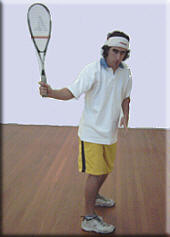
- Follow through to the target.
- Prepare for recovery to "T".
. More Pics... FH Follow through
More on Follow Through
 Squashgame Gold: Advanced Text and Video Content Squashgame Gold: Advanced Text and Video Content
More on Follow Through
- The rotation of the forearm will continue after racket ball impact, but the motion of the shot should continue through the ball and towards the target point for at least a short while.
- The racket will curve around the front of the body (the arm bends at the elbow) and the racket head will move upwards as rotation of the forearm is completed. If the arm is kept straight, the swing, especially on the backhand will become excessive.
- The follow through should be completed with the racket head on the opposite side of the body to the shot and at about head height.
- The racket then can be brought to a comfortable position in preparation for the next shot Simultaneously start to make the recovery to the T
The anomolies in a follow throughThe follow through can alter the direction of the ball.
- By stopping the swing (follow through) after hitting the ball can affect the power in the swing.
- By pulling the follow through across the body can alter the flight path and it is recommended taking the swing through towards the front wall target.
It is better to finish the swing with the racket head around shoulder height. Definitely keep the follow through and racket head from dangling around your legs. Video ResourcesDiscuss This Topic |


